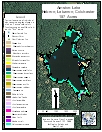Amston Lake, Hebron - 2006
During our August 2006 survey, the dominant species in the lake was eelgrass (Vallisneria
The floating-leaved species, watershield, white water lily (Nymphaea odorata), andyellow water lily (Nuphar variegata) all coexisted in shallow, protected parts of the lake, mostly notably in the eastern and northern-most coves. Pickerelweed (Pontederia cordata), an emergent species, was sparse and close to most of the shoreline. Other submerged species, including Charaphytes, spineless hornwort (Ceratophyllum echinatum), small waterwort (Elatine minima), needle spikerush (Eleocharis acicularis), sevenangle pipewort (Eriocaulon aquaticum), slender watermilfoil (Myriophyllum tenellum), largeleaf pondweed (Potamogeton amplifolius), snailseed pondweed (Potamogeton bicupulatus), floating leaf pondweed (Potamogeton natans), clasping-leaf pondweed (Potamogeton perfoliatus), small pondweed (Potamogeton pusillus), arrowhead (Sagittaria sp.), humped bladderwort (Utricularia gibba), purple bladderwort (Utricularia purpurea), floating bladderwort (Utricularia radiata), slender naiad (Najas flexilis), western waterweed (Elodea nuttallii) and unidentified sedge. These species occurred mostly in small patches around various places along the perimeter of the lake.
|
Species recorded in our 2006 survey of |
||
|
Charaphyte |
Sevenangle Pipewort |
Spineless Hornwort |
| Slender Naiad |
Watershield | |
| Slender Watermilfoil | Western Waterweed | |
| Small Waterwort | White Water Lily | |
| Snailseed Pondweed | Yellow Water Lily | |


